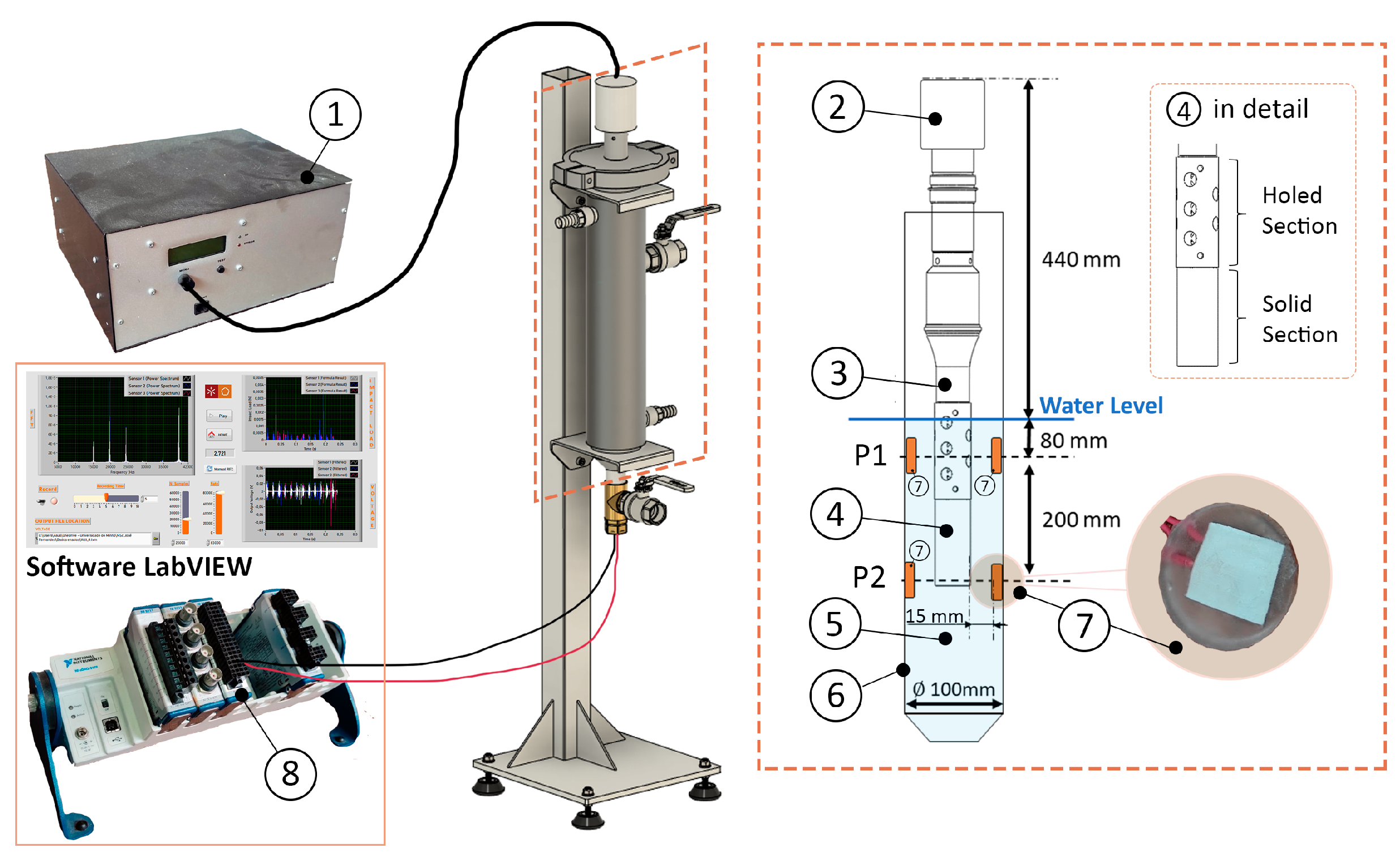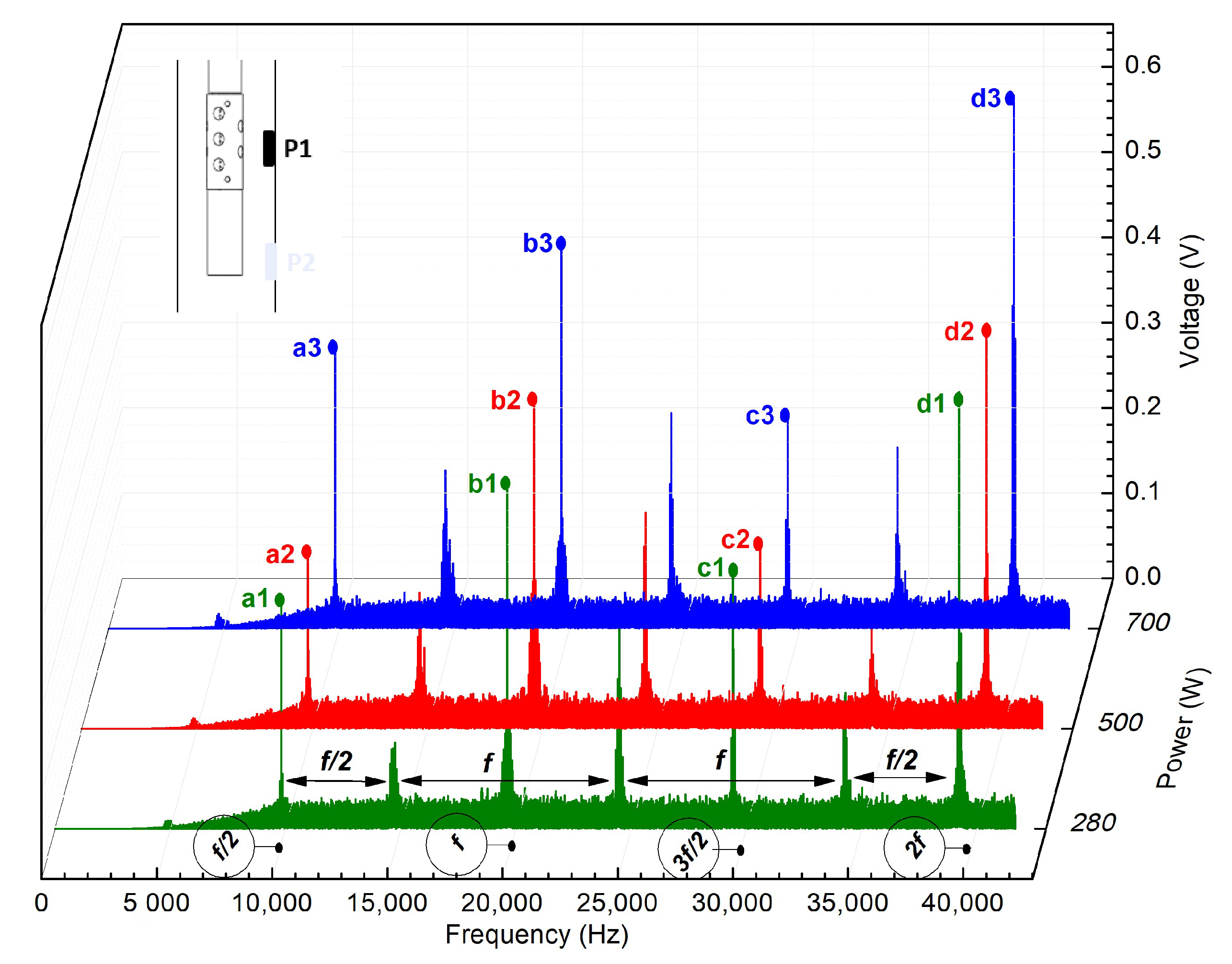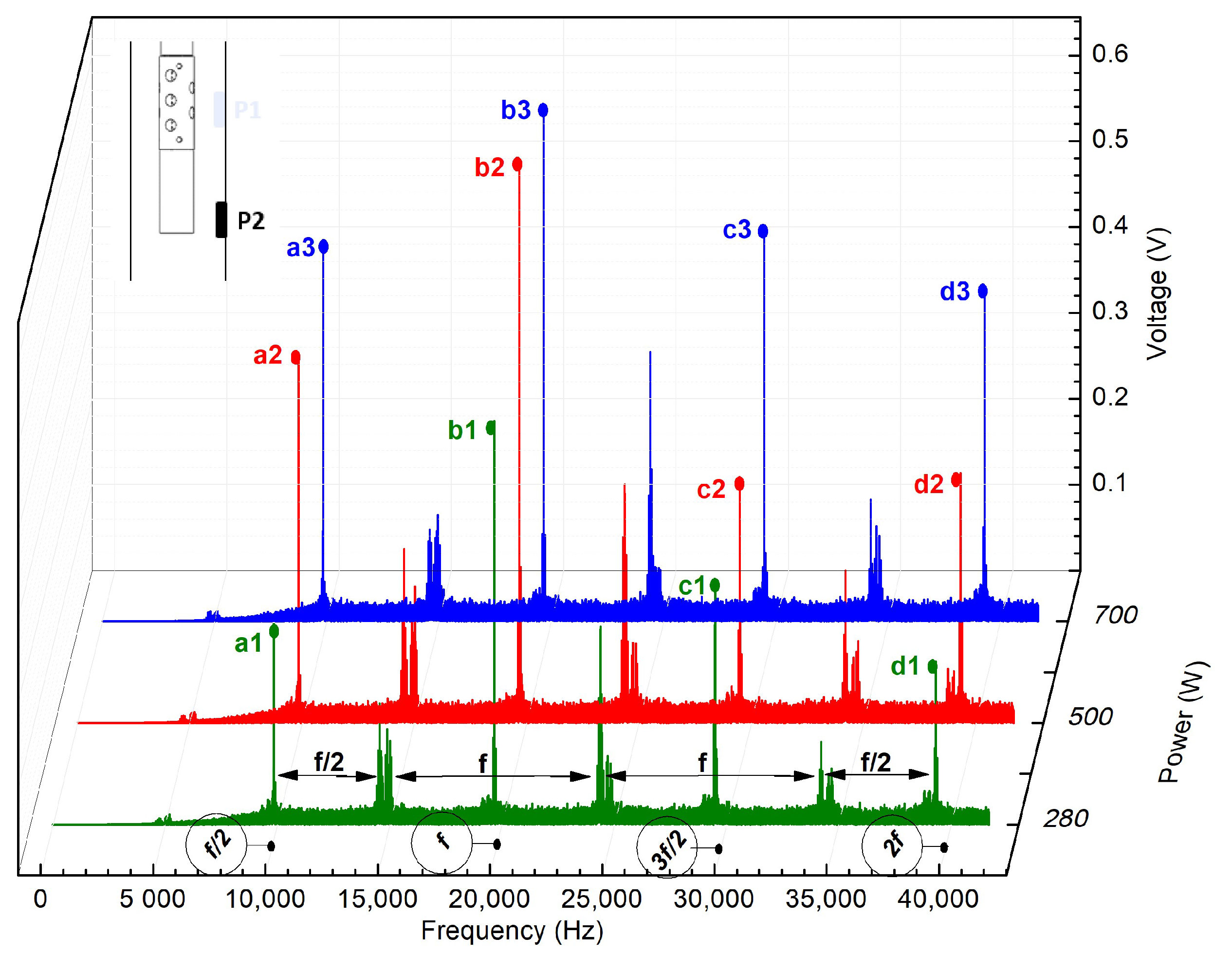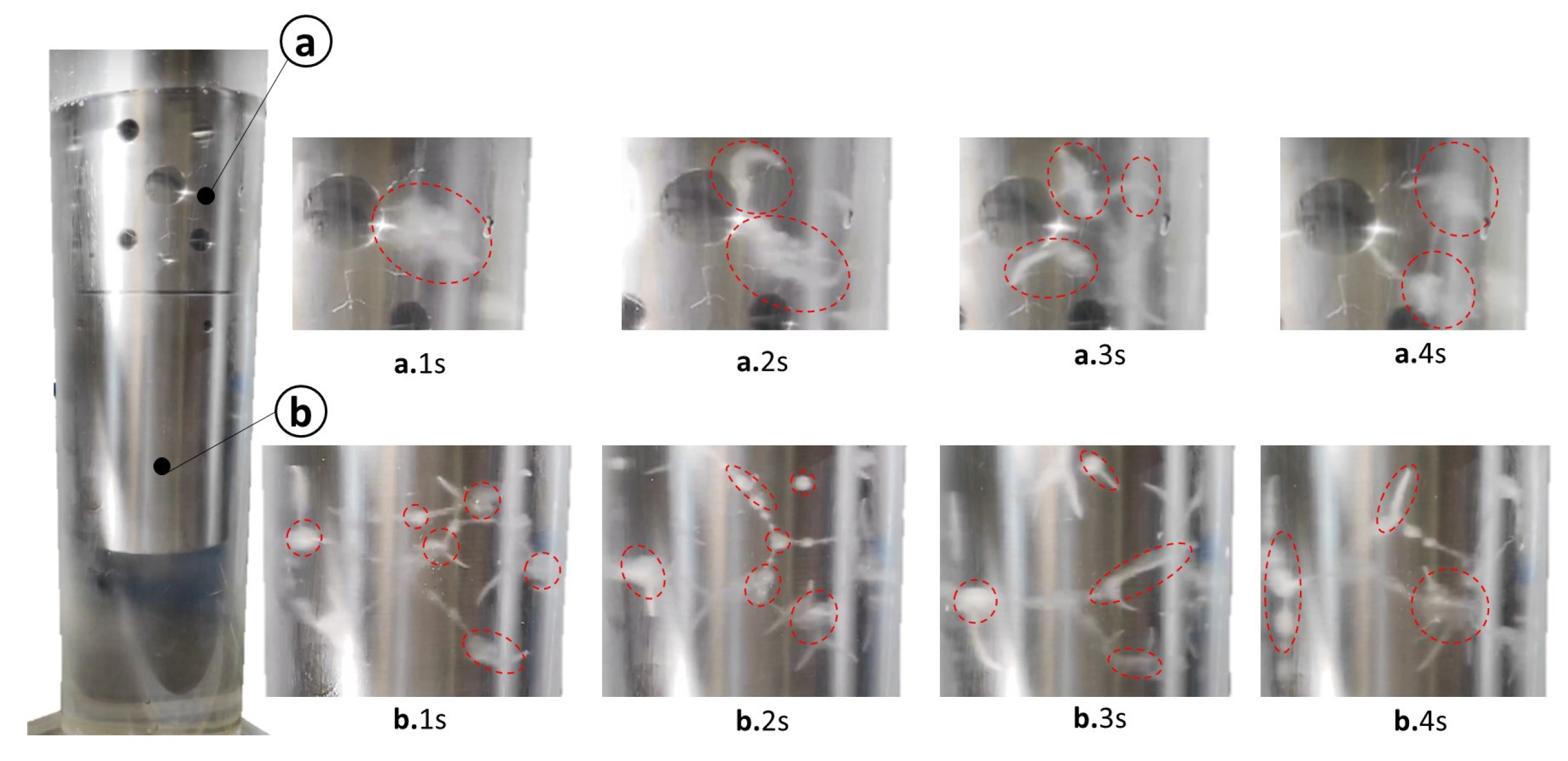Unveiling Acoustic Cavitation Characterization in Opaque Chambers through a Low-Cost Piezoelectric Sensor Approach
Abstract
:1. Introduction
| Acoustic Measurement Type | Description | Type of Sensor | Advantages | Disadvantages | References |
|---|---|---|---|---|---|
| Active | Cavitation is detected by reflecting ultrasound waves off the bubbles | Single transducer, linear array, bubble Doppler | High spatial time resolution and sensitivity when combined in linear array or bubble Doppler | Time-consuming; No real-time monitoring; Single transducer leads to spatial and focus limitations | [9,20,21,22,23] |
| Passive | Based on the spectrum estimation of cavitation noise emitted by cavitation bubbles | Fiber-optic | Low probe diameter; Fibers are completely wet and are not degradable in aggressive media; Measurements at high frequency with similar sensitivity to piezoelectric sensors | Less sensitive than piezoelectric sensors below 100 kHz; Does not allow precise location of cavitation; Low durability and some systems are complex to substitute; More susceptible to broadband noise fluctuations | [28,29,40,41] |
| Piezoelectric | Most commonly applied method; Signal clarity amidst minimal setup complexity; Allows real-time monitoring; Applicable across both laboratory and large-scale environments | May disrupt the acoustic field due to their bulk sensor design; Dependent on signal conversion to FFT by an auxiliary data treatment system; Can be damaged from cavitation activity; Not intended to achieve very high spatial resolutions | [24,25,26,27] | ||
| Self-Sensing | Capable of emitting and receiving acoustic signals from the cavitation of bubbles | Transducer | Sound field is not affected; Can withstand harsh process conditions; Ideal for application at high temperatures | Little research in this field; Difficult estimation of cavitation intensity through the current signal; Complex system on the transducer control; More susceptible to interferences | [9,32,33,34] |
2. Materials and Methods
2.1. Piezoelectric Sensor
2.2. Experimental Set-Up
2.3. Experimental Procedure
3. Results
3.1. Impedance Level Assessment
3.2. Cavitation Monitoring
4. Conclusions
Author Contributions
Funding
Data Availability Statement
Conflicts of Interest
References
- Yi, C.; Lu, Q.; Wang, Y.; Wang, Y.; Yang, B. Degradation of organic wastewater by hydrodynamic cavitation combined with acoustic cavitation. Ultrason. Sonochem. 2018, 43, 156–165. [Google Scholar] [CrossRef] [PubMed]
- Mason, T. Advances in Sonochemistry. J. Acoust. Soc. Am. 1994, 96, 613. [Google Scholar] [CrossRef]
- Ameta, S.; Ameta, R. Advanced Oxidation Processes for Wastewater Treatment: Emerging Green Chemical Technology; Elsevier Science: Amsterdam, The Netherlands, 2018. [Google Scholar] [CrossRef]
- Hassani, A.; Malhotra, M.; Karim, A.V.; Krishnan, S.; Nidheesh, P.V. Recent progress on ultrasound-assisted electrochemical processes: A review on mechanism, reactor strategies, and applications for wastewater treatment. Environ. Res. 2022, 205, 112463. [Google Scholar] [CrossRef] [PubMed]
- Ameta, S.; Ameta, R.; Ameta, G. Sonochemistry: An Emerging Green Technology; Apple Academic Press: Palm Bay, FL, USA, 2018. [Google Scholar]
- Verhaagen, B.; Rivas, D.F. Measuring cavitation and its cleaning effect. Ultrason. Sonochem. 2016, 29, 619–628. [Google Scholar] [CrossRef] [PubMed]
- Zhu, X.; Das, R.S.; Bhavya, M.L.; Garcia-Vaquero, M.; Tiwari, B.K. Acoustic cavitation for agri-food applications: Mechanism of action, design of new systems, challenges and strategies for scale-up. Ultrason. Sonochem. 2024, 105, 106850. [Google Scholar] [CrossRef] [PubMed]
- Sutkar, V.S.; Gogate, P.R. Design aspects of sonochemical reactors: Techniques for understanding cavitational activity distribution and effect of operating parameters. Chem. Eng. J. 2009, 155, 26–36. [Google Scholar] [CrossRef]
- Wu, P.; Wang, X.; Lin, W.; Bai, L. Acoustic characterization of cavitation intensity: A review. Ultrason. Sonochem. 2022, 82, 105878. [Google Scholar] [CrossRef]
- Laborde, J.L.; Bouyer, C.; Caltagirone, J.P.; Gérard, A. Acoustic cavitation field prediction at low and high frequency ultrasounds. Ultrasonics 1998, 36, 581–587. [Google Scholar] [CrossRef]
- Krefting, D.; Mettin, R.; Lauterborn, W. High-speed observation of acoustic cavitation erosion in multibubble systems. Ultrason. Sonochem. 2004, 11, 119–123. [Google Scholar] [CrossRef]
- Gelderblom, E.C.; Vos, H.J.; Mastik, F.; Faez, T.; Luan, Y.; Kokhuis, T.J.; van der Steen, A.F.; Lohse, D.; de Jong, N.; Versluis, M. Brandaris 128 ultra-high-speed imaging facility: 10 years of operation, updates, and enhanced features. Rev. Sci. Instrum. 2012, 83, 103706. [Google Scholar] [CrossRef]
- Zijlstra, A.; Rivas, D.F.; Gardeniers, H.J.; Versluis, M.; Lohse, D. Enhancing acoustic cavitation using artificial crevice bubbles. Ultrasonics 2015, 56, 512–523. [Google Scholar] [CrossRef]
- Soare, A.; Dijkink, R.; Pascual, M.R.; Sun, C.; Cains, P.W.; Lohse, D.; Stankiewicz, A.I.; Kramer, H.J.M. Crystal Nucleation by Laser-Induced Cavitation. Cryst. Growth Des. 2011, 11, 2311–2316. [Google Scholar] [CrossRef]
- Sukovich, J.R.; Haskell, S.C.; Xu, Z.; Hall, T.L. A cost-effective, multi-flash, “ghost” imaging technique for high temporal and spatial resolution imaging of cavitation using “still-frame” cameras. J. Acoust. Soc. Am. 2020, 147, 1339–1343. [Google Scholar] [CrossRef]
- Fuchs, J.; Ultrasonics, B.N. Ultrasonic intensity measurement techniques. In CleanTech Symposium Proceedings; Witter Publications: Flemington, NJ, USA, 2002. [Google Scholar]
- Arvanitis, C.D.; McDannold, N. Integrated ultrasound and magnetic resonance imaging for simultaneous temperature and cavitation monitoring during focused ultrasound therapies. Med. Phys. 2013, 40, 112901. [Google Scholar] [CrossRef]
- De Santis, P.; Sette, D.; Wanderlingh, F. Cavitation Detection: The Use of the Subharmonics. J. Acoust. Soc. Am. 1967, 42, 514–516. [Google Scholar] [CrossRef]
- Kuroyama, T.; Ogasawara, H.; Mori, K. Characterization as measurement sound source of acoustic cavitation noise from bubble clusters under ultrasonic horn. Jpn. J. Appl. Phys. 2023, 62, SJ1032. [Google Scholar] [CrossRef]
- Madanshetty, S.I.; Roy, R.A.; Apfel, R.E. Acoustic microcavitation: Its active and passive acoustic detection. J. Acoust. Soc. Am. 1991, 90, 1515–1526. [Google Scholar] [CrossRef]
- Ding, T.; Hu, H.; Bai, C.; Guo, S.; Yang, M.; Wang, S.; Wan, M. Spatial-temporal three-dimensional ultrasound plane-by-plane active cavitation mapping for high-intensity focused ultrasound in free field and pulsatile flow. Ultrasonics 2016, 69, 166–181. [Google Scholar] [CrossRef] [PubMed]
- Li, T.; Khokhlova, T.D.; Sapozhnikov, O.A.; O’Donnell, M.; Hwang, J.H. A new active cavitation mapping technique for pulsed HIFU applications-bubble Doppler. IEEE Trans. Ultrason. Ferroelectr. Freq. Control 2014, 61, 1698–1708. [Google Scholar] [CrossRef]
- Ding, T.; Zhang, S.; Fu, Q.; Xu, Z.; Wan, M. Ultrasound line-by-line scanning method of spatial–temporal active cavitation mapping for high-intensity focused ultrasound. Ultrasonics 2014, 54, 147–155. [Google Scholar] [CrossRef]
- Puga, H.; Barbosa, J.; Gabriel, J.; Seabra, E.; Ribeiro, S.; Prokic, M. Evaluation of ultrasonic aluminium degassing by piezoelectric sensor. J. Mater. Process. Technol. 2011, 211, 1026–1033. [Google Scholar] [CrossRef]
- Zeqiri, B.; Gelat, P.; Hodnett, M.; Lee, N. A novel sensor for monitoring acoustic cavitation. Part I: Concept, theory, and prototype development. IEEE Trans. Ultrason. Ferroelectr. Freq. Control 2003, 50, 1342–1350. [Google Scholar] [CrossRef] [PubMed]
- Chen, J.C.; Chang, H.Y.; Chen, J.J.; Chen, G.S. A Piezoceramic Sensor for Detection of Focused Ultrasound-Induced Cavitation. IEEE Sens. J. 2019, 19, 10379–10385. [Google Scholar] [CrossRef]
- Wang, Y.C.; Huang, C.H.; Lee, Y.C.; Tsai, H.H. Development of a PVDF sensor array for measurement of the impulsive pressure generated by cavitation bubble collapse. Exp. Fluids 2006, 41, 365–373. [Google Scholar] [CrossRef]
- Arvengas, A.; Davitt, K.; Caupin, F. Fiber optic probe hydrophone for the study of acoustic cavitation in water. Rev. Sci. Instrum. 2011, 82, 034904. [Google Scholar] [CrossRef]
- Kimura, K.; Takeuchi, S.; Koike, Y. Investigation of Cavitation Bubble Influence on Frequency Spectrum of Fiber Optic Probe Hydrophone Output. In Proceedings of the 2020 IEEE International Ultrasonics Symposium (IUS), Las Vegas, NV, USA, 7–11 September 2020; pp. 1–4. [Google Scholar] [CrossRef]
- Bull, V.; Civale, J.; Rivens, I.; ter Haar, G. A Comparison of Acoustic Cavitation Detection Thresholds Measured with Piezo-electric and Fiber-optic Hydrophone Sensors. Ultrasound Med. Biol. 2013, 39, 2406–2421. [Google Scholar] [CrossRef]
- Tzanakis, I.; Hodnett, M.; Lebon, G.; Dezhkunov, N.; Eskin, D. Calibration and performance assessment of an innovative high-temperature cavitometer. Sens. Actuators A Phys. 2016, 240, 57–69. [Google Scholar] [CrossRef]
- Saalbach, K.A.; Twiefel, J.; Wallaschek, J. Self-sensing cavitation detection in ultrasound-induced acoustic cavitation. Ultrasonics 2019, 94, 401–410. [Google Scholar] [CrossRef] [PubMed]
- Saalbach, K.A.; Twiefel, J.; Wallaschek, J. Self-sensing cavitation detection capability of horn geometries for high temperature application. J. Vibroeng. 2016, 18, 989–998. [Google Scholar] [CrossRef]
- Bornmann, P.; Hemsel, T.; Sextro, W.; Memoli, G.; Hodnett, M.; Zeqiri, B. Self-sensing ultrasound transducer for cavitation detection. In Proceedings of the 2014 IEEE International Ultrasonics Symposium, Chicago, IL, USA, 3–6 September 2014; pp. 663–666. [Google Scholar] [CrossRef]
- Zhu, J.; Yang, Y.; Zhang, H.; Zhao, Z.; Hu, T.; Liu, L. More Than Energy Harvesting in Electret Electronics-Moving toward Next-Generation Functional System. Adv. Funct. Mater. 2023, 33, 2214859. [Google Scholar] [CrossRef]
- Rupitsch, S. Piezoelectric Sensors and Actuators: Fundamentals and Applications; Topics in Mining, Metallurgy and Materials Engineering; Springer: Berlin/Heidelberg, Geramny, 2018. [Google Scholar] [CrossRef]
- Matei, N.; Scarpete, D. The Use of Ultrasound in the Treatment Process of Wastewater: A Review. Ann. “Dunarea de Jos” Univ. Galati Fascicle IX Metall. Mater. Sci. 2015, 2, 45–50. [Google Scholar]
- Vijaya, M. Piezoelectric Materials and Devices: Applications in Engineering and Medical Sciences; CRC Press: Boca Raton, FL, USA, 2016. [Google Scholar] [CrossRef]
- Apfel, R.E. Acoustic Cavitation. Ultrasonics 1981, 19, 355–411. [Google Scholar] [CrossRef]
- Jiang, Z.; Sujarittam, K.; Yildiz, B.I.; Dickinson, R.J.; Choi, J.J. Passive Cavitation Detection with a Needle Hydrophone Array. IEEE Trans. Ultrason. Ferroelectr. Freq. Control 2022, 69, 233–240. [Google Scholar] [CrossRef] [PubMed]
- Zubalic, E.; Vella, D.; Babnik, A.; Jezeršek, M. Interferometric Fiber Optic Probe for Measurements of Cavitation Bubble Expansion Velocity and Bubble Oscillation Time. Sensors 2023, 23, 771. [Google Scholar] [CrossRef] [PubMed]
- Brabec, K.; Mornstein, V. Detection of ultrasonic cavitation based on low-frequency analysis of acoustic signal. Open Life Sci. 2007, 2, 213–221. [Google Scholar] [CrossRef]
- Abramov, O.V. High-Intensity Ultrasonics, 1st ed.; CRC Press: Boca Raton, FL, USA, 1999. [Google Scholar] [CrossRef]
- Eskin, G.; Eskin, D. Ultrasonic Treatment of Light Alloy Melts; Advances in Metallic Alloys; CRC Press: Boca Raton, FL, USA, 2017. [Google Scholar] [CrossRef]
- Bai, L.; Xu, W.; Deng, J.; Li, C.; Xu, D.; Gao, Y. Generation and control of acoustic cavitation structure. Ultrason. Sonochem. 2014, 21, 1696–1706. [Google Scholar] [CrossRef]
- Moussatov, A.; Granger, C.; Dubus, B. Cone-like bubble formation in ultrasonic cavitation field. Ultrason. Sonochem. 2003, 10, 191–195. [Google Scholar] [CrossRef]







Disclaimer/Publisher’s Note: The statements, opinions and data contained in all publications are solely those of the individual author(s) and contributor(s) and not of MDPI and/or the editor(s). MDPI and/or the editor(s) disclaim responsibility for any injury to people or property resulting from any ideas, methods, instructions or products referred to in the content. |
© 2024 by the authors. Licensee MDPI, Basel, Switzerland. This article is an open access article distributed under the terms and conditions of the Creative Commons Attribution (CC BY) license (https://creativecommons.org/licenses/by/4.0/).
Share and Cite
Fernandes, J.; Ramísio, P.J.; Puga, H. Unveiling Acoustic Cavitation Characterization in Opaque Chambers through a Low-Cost Piezoelectric Sensor Approach. Electronics 2024, 13, 1581. https://doi.org/10.3390/electronics13081581
Fernandes J, Ramísio PJ, Puga H. Unveiling Acoustic Cavitation Characterization in Opaque Chambers through a Low-Cost Piezoelectric Sensor Approach. Electronics. 2024; 13(8):1581. https://doi.org/10.3390/electronics13081581
Chicago/Turabian StyleFernandes, José, Paulo J. Ramísio, and Hélder Puga. 2024. "Unveiling Acoustic Cavitation Characterization in Opaque Chambers through a Low-Cost Piezoelectric Sensor Approach" Electronics 13, no. 8: 1581. https://doi.org/10.3390/electronics13081581







